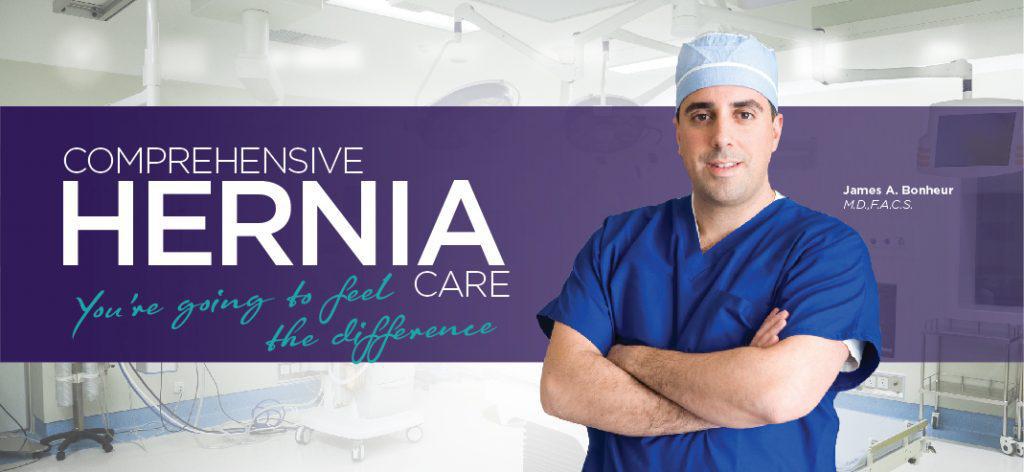Hernia Repair

UPDATE: Check out our Hernia Center of Connecticut website for more information about Hernia Causes, Treatment, Removal and much more!
Request Appointment
ABOUT YOUR HERNIA
In the United States, over 600,000 laparoscopic hernia repair operations are performed annually. Many of these repairs are performed by the conventional “open” method whereas some are performed laparoscopically (minimally invasive surgery). Laparoscopic hernia repair is a relatively new procedure that offers patients less postoperative pain, better cosmetic results and a quicker return to work and normal activities.
WHAT IS A HERNIA?
A hernia is a weakness in the abdominal wall resulting in the abnormal protrusion of abdominal contents (e.g. intestines) through the weakness or defect. Similar to the inner tube pushing through a damaged tire, the inner lining of the abdomen pushes through the weakened area of the abdominal wall. As the hernia enlarges over time, it can become painful and in some instances may lead to more serious problems requiring emergency surgery.
HOW DO I KNOW IF I HAVE A HERNIA?
The most common hernias are:
-
INGUINAL HERNIA
(groin), the most common type
-
SPORTS HERNIA
(groin area)
-
UMBILICAL
around the belly button
-
INCISIONAL
through a scar
-
HIATAL
A SMALL OPENING IN THE DIAPHRAGM THAT ALLOWS THE UPPER PART OF THE STOMACH TO MOVE UP INTO THE CHEST.
OTHER HERNIAS
- Spigelian hernia, (lateral ventral hernia)
- A femoral hernia, (below the groin/inguinal area)
- Epigastric hernia, (upper abdominal wall hernia)
- Internal hernia, (hernia within the abdominal cavity)
Larger hernias are usually easy to identify, although smaller ones may be a bit more challenging. Hernias present as a bulge under the skin that may come and go depending on your position (standing vs. lying down) or during periods of straining or exertion (lifting a heavy object or coughing). Some bulges are painless, while others may present as severe pain. Most people experience a dull ache that may worsen during periods of prolonged standing or during periods of exertion or straining. Severe, continuous pain, redness and tenderness are signs that the hernia may be entrapped or strangulated. These symptoms are cause for concern and you should seek immediate attention.
WHAT CAUSES A HERNIA?
Hernias are either acquired (you over exerted yourself) or congenital (you were born with it). Throughout our abdominal wall, there are natural areas of potential weakness. Hernias can develop at these or other areas due to heavy strain, aging, injury, an old incision or a weakness present from birth. Hernia can occur at any age, and are more common in men. Most hernias in children are congenital. In adults, a natural weakness or strain from heavy lifting, persistent coughing or constipation can cause the abdominal wall to weaken or separate resulting in a hernia.
TREATMENT OPTIONS
Non-surgical option: Hernias get worse over time, not better. That said there are no acceptable non-surgical treatments for a hernia. The use of a truss (hernia belt) or abdominal binder can help keep the hernia from bulging but eventually this will fail. Moreover, a truss or binder can promote the formation of scar tissue around the hernia making the repair more difficult. Surgical Options: Laparoscopic (minimally invasive) technique using a tension free repair Advantages:
- More than one hernia can be repaired at the same time (umbilical, incisional and a groin hernia).
- Same-day surgery
- Incisions are smaller
- There is less pain
- Motivated patients may return to work in 2-3 days
- You may return to normal lifting within a couple of weeks with few limitations.
- Evaluation of the abdominal cavity can be performed to assess other potential causes of pain.
- Solid repair with a mesh used to bridge the defect. Tension free repair
Disadvantages:
- Requires general anesthesia, cannot be done under local.
Conventional (Open technique) using a tension free repair Advantages:
- Can be done under local anesthesia
- Same day surgery
- Good repair using a mesh to bridge the defect. Tension free repair
Disadvantages:
- More pain
- Larger incision
- No strenuous activity or heavy lifting for approximately 3 months.
- Generally repair one hernia at a time, thereby prolonging your recovery
RISKS ASSOCIATED WITH SURGERY:
- Bleeding
- Infection
- Injury to intra-abdominal contents.
- Testicular injury
- Chronic pain
- Blood clot to the lungs
(This is only a partial list of potential complications)
PRE-OPERATIVE PREPARATION
May include blood work, urinalysis, abdominal x-rays, and an abdominal CT scan.
AVERAGE HOSPITAL STAY
Most hernia repairs are performed on an outpatient basis (patients go home the same day). Larger hernias or patients with associated medical conditions may require a hospital stay.
TYPE OF ANESTHESIA REQUIRED
Laparoscopic surgery requires general anesthesia which blocks pain and keeps you asleep throughout the entire surgery.
Laparoscopic hernia repair recovery time
Once you have undergone laparoscopic surgery, your recovery period is relatively short when compared to conventional open surgery. Most patients go home the same day and return to work as early as 2-3 days (average 7-10days). You will be given pain medication along with a laxative to prevent constipation. If you suspect you have a hernia, consult with your primary care physician promptly. Hernias tend to get bigger over time and do not resolve without treatment. Delaying your hernia repair can result in intestinal incarceration (intestine is trapped inside the hernia sac) or strangulation (intestine is trapped and develops gangrene). The latter is a surgical emergency. Under certain circumstances, the hernia may be watched and followed closely by a physician. Consult your physician to determine if the observation is the proper course of action.
LEARN MORE ABOUT OUR SERVICES
Acid Reflux
more info
Aesthetic Treatments
more info
more info
more info
Gastric Banding
more info
Gastric Bypass
more info
Gastric Sleeve
more info
General Surgery
more info
GERD
more info
more info
more info
Laparoscopic Surgery
more info
more info
more info
more info
more info
Sclerotherapy
more info
more info
Varicose Veins
more info
more info
OUR LOCATION